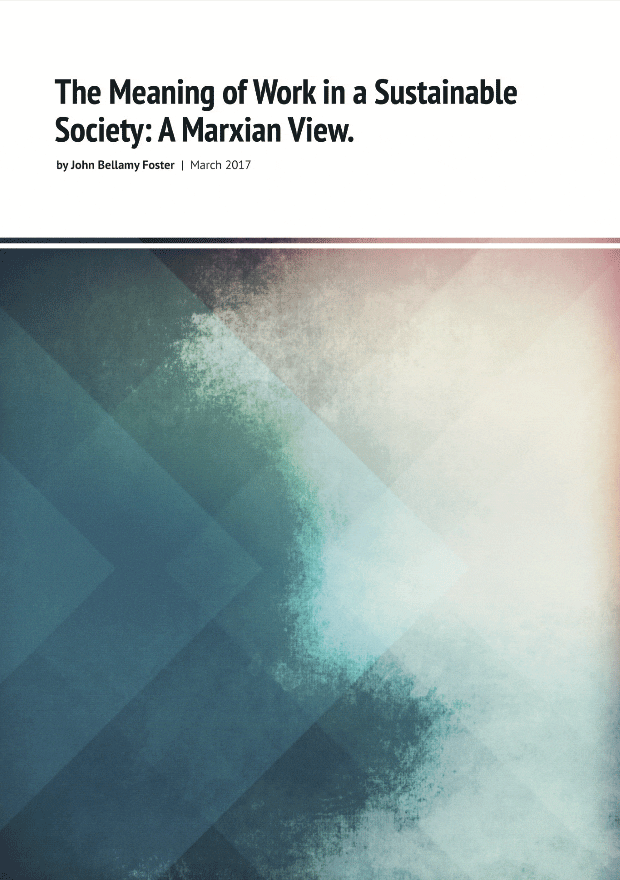Artists as workers. A response to John Bellamy Foster
by KATE OAKLEY
Any vision of sustainable prosperity must include a notion of better work, not just more work (and less unemployment) and John Bellamy Foster’s essay is to be warmly welcomed for putting the question of what constitutes ‘good work’ on the table. But I fear that by arguing – at least in part – that good work looks like creative work or artistic work, it risks perpetuating certain ideas about artistic production that will harm, rather than aid, the struggle for good work. In drawing on William Morris (and indeed Marx’s) ideas of artistic production as unalienated labour, we risk idealising a model of work which is individualistic, self-exploiting and ultimately, exclusionary.
In his seminal essay, The Mental Labour Problem[i], Andrew Ross compared conditions of artistic and academic labour at the close of the twentieth century. These were fields which had been historically resistant to industrial-style organisation, had retained a commitment to forms of craft labour and ideas of autonomy which were being threatened by managerialism and the growth of neoliberalism and which, just as conditions were being degraded and casualised, were simultaneously being held up as models of good work in the ‘knowledge economy.’ As writers such as Richard Florida celebrated the go-getting entrepreneurialism of the ‘creative,’ and the bohemian flex-worker was promoted as the answer to every declining city or town in the global North – actual conditions of labour in the arts, in the media and wider cultural industries were getting worse, and the growth of what would become known as the ‘precariat’ was apparent.
That the arts labour force now includes many members of this precariat, that low pay and no-pay is rife and that, in part as a consequence, a highly un-representative labour market has developed in which women, working class people, ethnic minorities and the disabled are under-represented, is now well-established.[ii] There is no suggestion that Bellamy Foster would be anything other than sympathetic to efforts to combat this situation, some of which are underway and are supported by growing numbers of cultural workers[iii]. But the ideals of artistic work, what Ross elsewhere calls the ‘training in sacrificial labour[iv]’ that artists bring to their work, is something which also merits critical examination.
As Ross notes, and I have observed myself over years of interviewing workers in the cultural sector, the idea that artistic work is special, that is should not be tainted by monetary consideration and that devoting oneself to it, even at the cost of one’s health or relationships is a noble pursuit, is remarkably resistant. I find myself often talking to young cultural workers, not lamenting their commercialism or the corrosion of their artistic ideals, but instead wishing that they saw themselves as workers, as people (collectively) producing things of value and deserving of decent treatment. After all, there is no self-exploitation without exploitation of others. To be willing to work excessive hours ‘to get the job done,’ to discount your labour for the chance at self-expression or to produce for free what was once paid-for content is to help create a climate of unsustainable work which excludes those whose families cannot support them through unpaid work, or who have caring responsibilities, or simply need to pay the rent.
There are other traditions that cultural workers can draw on; Morris’ medieval craftsman is not the only one. Cultural workers have at different times also been heavily unionised, have fought for a reasonable working week and decent pay and have celebrated the values of solidarity as well as autonomy. These are traditions to which we should pay more attention if we want to challenge precarity and rescue a progressive role for labour.
—
[i] Ross, A. 2000. The Mental Labor Problem. Social Text 18.2, pp 1-31
[ii] Oakley, K & O’Brien, D. 2016. Learning to labour unequally: understanding the relationship between cultural production, cultural consumption and inequality, Social Identities: Journal for the Study of Race, Nation and Culture.
[iii] See for example https://culturalworkersorganize.org
[iv] Ross, A. 2002. No Collar. The Humane Workplace and its Hidden Costs. Temple University Press.

